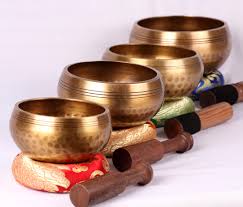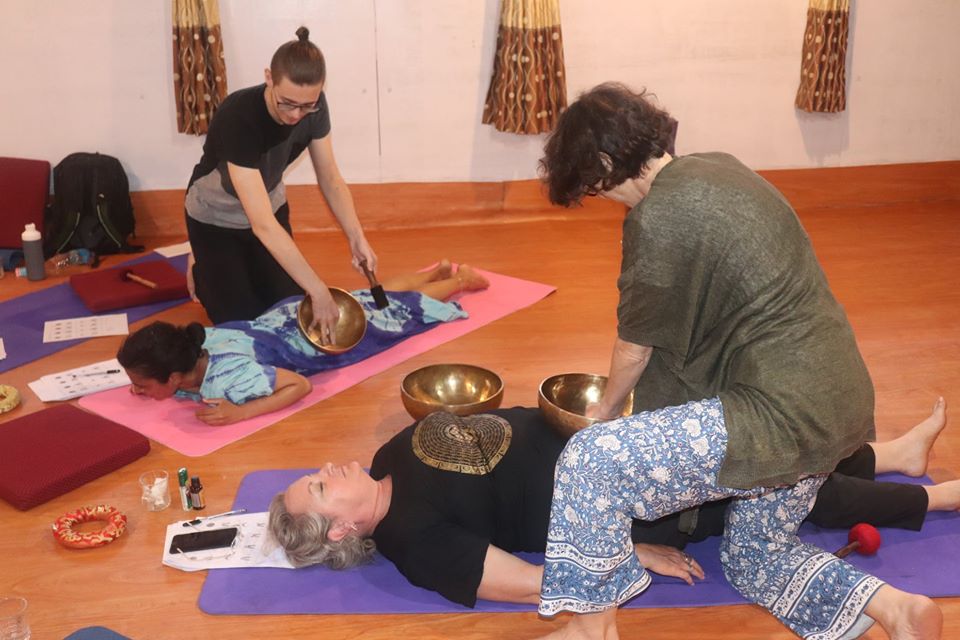Use of Singing bowl
Are you interested to know the use of Singing Bowl? The sound vibration of the singing bowl purifies the surrounding throughout the area of its sound. This also pacifies the mind of the listener. So, they are used to create positive vibration for cleansing the environment and soothing the mind. Singing bowls have become popular with yogis since it is very good to create spiritual waves. They may be played during a yoga-asana class, especially during savasana to deepen the practice ( Click here to See how to play singing bowl here).
They are also played during chanting and meditation. The Nepali, Indian, Tibetan people have been practicing sound healing and consciousness transformation with “singing bowls” for centuries. Singing bowls are perfect to support in meditation. They are kept in meditation hall, yoga hall, monasteries and temple all over the world.
Use of Singing bowls are widely spread to accompany meditation and chanting programs. They are also used for religious and spiritual purposes as a part of a tradition. The musical sound produced by singing bowl helps for deeper meditation and relaxation thus accelerates spiritual progress. Use of Singing bowls are now inevitable in sound healing and therapy.
Use of singing bowl as Vibrational activities
Researches have done insightful perusal on the vibrational behavior of bowls and emulated under both condition. The conditions are rubbing-inveigled puja provocation and situation after the strike. The experiment in the quondam case manifests that bowls reveal the sound movement at a tangent and at a radius. The modes of movement are in simultaneous constant and fickle. Like that of the angular velocity of puja, the fickle style rotates around the bowl.
The hitting occurrence is always heard, with an utter symmetric bowl. A harder puja, lower contact force, may create rattling or chattering sound with huger angular motion. People have done researches using loudspeaker-stimulated vibration as well. The behavior of partially water-filled bowls has been detected varying the style of echo reaction with temperature and also varies in the traits of blob-emission from the fluid stratum according to temperature. One of the studies has made a report in 2011 on the BBC which includes slow-motion video.
The vibrations of its sound are like acupuncture needles which are efficient to aid vital energy flow freely. The shiatsu strokes and pressure helps the vibration in the same way to connect the mind of the recipient deeply. This helps to disconnect the worries making a good and helping to experience the present moment
Use of Singing bowls for these benefits
The experiment shows that singing bowl sound has an effect on improve memory, lucidity, vigor, and animateness to take action. Many people have experienced inner tranquility, sound sleep, and better health due to early healing of different types of sufferings. Some other benefits are
· Good relaxation and better sleep
· Chakra Balancing
· Rejuvenation
· Increases mental clarity and understanding
· Enhanced life force energy
· Meditation
· Reduce chronic fatigue syndrome and depression
. Relief pain and discomfort from fibromyalgia
Singing bowls are also used in music

The celuring-set, sparse equipment during 1968 AD was available only in pivotal Javanese reign according to a reference. It is comprised of a big ornate texture. Its top was attached a group of bronze bowls which were half-coconut-shaped to which a short iron bar is used to strike.
From the early 1970s, the West started to import the bowls with singing-aptitude. Henry Wolff and Nancy Hennings were the musicians who are given credit for the singing bowl’s introduction in music in their 1972new-age album Tibetan Bells. This was the first, and there were five related series were released. With music as a cicerone, the concept of the albums is taking to the metaphysical travel.
“Tibetan music” was a peerless way of Wolff and Hennings’ seminal recording of American singing bowl. It became famous in America with many recordings. In the 1980s, since establishment, those terms people started to market it as World music or New-age music. So ‘Tibetan singing bowls’ have taken place as an eminently visual and musical glyph in Tibet. Its range is very long till America, the most widespread ultramodern characterization of Tibet.
Jem Finer has done a musical composition called “Longplayer”. From a brief slice of origin music play cumulatively, six recorded selections at diverse pitches and velocity. It is assembled such that no association is encored until one millennium is

